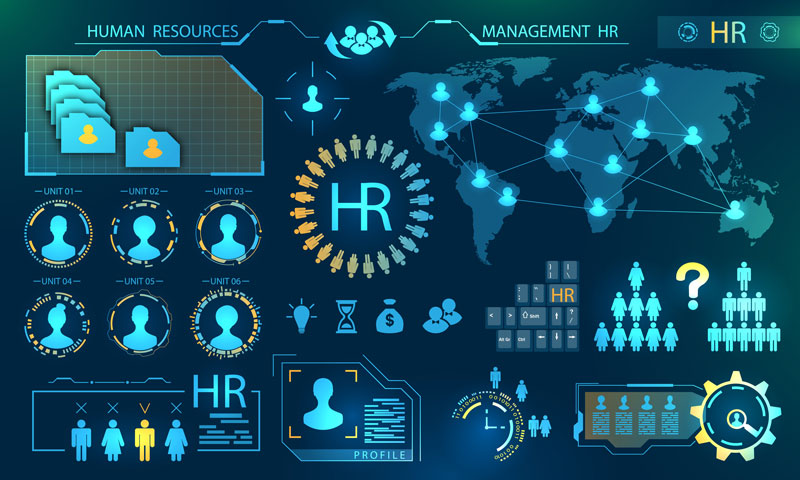Major disruptions like the recent pandemic have resulted in a substantial labor shortage within the United States—an event now referred to as The Great Resignation. According to the Labor Department’s latest Job Openings and Labor Turnover report, 47.4 million people voluntarily left their jobs in 2021, citing reasons such as inadequate pay, no respect from higher-ups, and poor workplace conditions. In another study conducted by Microsoft, 52% of surveyed Gen Z and Millennials responded that they are likely to consider changing employers this year.
Due to the expensive costs associated with recruiting and onboarding new employees, more and more businesses are turning to HR data analytics for retaining their workforce and enhancing their business strategy. When coupled with a data-friendly culture and committed leadership, HR analytics can allow businesses to capitalize on opportunities for improvement and address potential challenges in workplace productivity.
Talent acquisition
A strong and qualified workforce forms the backbone of any business, so it’s important that managers pay attention to how and who they’re hiring.
Hiring process
Even before the actual hiring process has begun, businesses should be evaluating what their company needs are and what kind of positions they should be trying to fill. Metrics related to current openings and weaknesses in their workflow can help businesses identify where they need to direct their recruiting resources. This is important for both full-time positions and internships.
Once a business has identified its recruitment goals, it can begin the long process of advertising, screening, and interviewing potential employees. At every step of the way, managers should be employing data analytics to manage their large pool of candidates and evaluate their throughput and what it’s costing them.
Metrics related to the average number of applications, how those applications are coming through, and how many of those applications are translating to meaningful interviews enables managers to better allocate recruitment resources and determine which hiring channels are yielding the best results.
Acceptance & onboarding
Following the necessary screenings and interviews, businesses should leverage acceptance rate data to optimize their recruitment pipeline and ensure that current methodologies are a worthwhile investment.
Metrics related to the time to hire and cost per hire provide insight into how much revenue has been lost due to unfilled positions and how an employee’s human capital compares to the costs of bringing them on board.
Additionally, the sooner an employee is brought up to working speed, the sooner that person can start generating revenue. This is why metrics like time to productivity are so crucial for businesses looking to make the most of their ROI.

Productivity
Employees who aren’t productive or meeting certain benchmarks can cost a company more than they’re worth. With this in mind, data analytics can allow businesses to determine which staff may need additional training or identify obstacles that interfere with employee workflows.
Performance & meeting benchmarks
There are a wide variety of metrics available for HR departments to use in evaluating how staff are performing and whether or not they’re contributing efficiently towards long-term business strategies.
Some of the most popular methods of tracking employee performance include:
- Self-assessments
- Peer reviews
- Manager assessments
- Customer retention/engagement
- Progress towards set benchmarks
To build on this, businesses can also use these metrics to determine which employees would be good candidates for position advancement and leadership training. It’s important that performance data not only be used to address immediate hindrances, but also to plan for the long-term.
ROI
At the end of the day, employees are either costing or generating revenue for a business. Human capital ROI is a cost-based metric that evaluates the financial value added by the workforce in relation to the money spent on salaries and benefits.
Determining a business’s human capital ROI requires metrics on both employee compensation and the profit/revenue per employee. Additionally, an employee’s value may require other forms of measurement if their financial payoff is less transparent.
Many businesses also fail to account for the costs associated with managing these employees and how many employees are assigned per manager.

Retention
With the onset of The Great Resignation, workforce retention has become a major hurdle for businesses everywhere as employees seek out superior compensation and working conditions. One of the best ways to gain a better understanding of how a business’s workforce fares long-term is by measuring its turnover and resignation rate.
Turnover rate
A business’s turnover rate is the number of employees who leave an organization within a given period of time in relation to the total number of employees. This number can be further broken down by whether or not the turnover was voluntary, how well-performing those employees were, and how turnover rates compare between different departments and managers.
Similar to how businesses can track the costs of hiring employees, businesses can also measure the costs of losing employees. This entails measuring data related to separation, vacancy, replacement, and training costs resulting from employee turnover.
Retention rate
Opposite of a business’s turnover rate, the retention rate is the number of employees who remained in an organization over a given period of time in relation to the total number of employees. Likewise, this number can be explored further by adding more specified metrics such as how retention rates compare between different teams and managers.
In order to evaluate the risk of future resignations, businesses can measure employee satisfaction and intent to stay through surveys. Measuring resignation rates by years of service and recording whether or not the departing employee is retiring can also provide some insight into how job satisfaction may have played a part in an employee’s decision.
Attrition rate
Employee attrition is similar to turnover. However, whereas turnover entails the departure of employees that a business intends to replace, attrition occurs when the business opts not to fill the vacancy left by the departing employee, or even eliminates that particular role altogether. Employers have to track data related to both turnovers and attrition in order to understand how to align their workforce with long-term goals.

Learning & development
Let’s say you’ve found a way to efficiently maintain your best employees and cut down on turnover costs—how do we then continue to capitalize on their potential and make sure they grow with the company?
The key is continued learning through the implementation of effective training and education programs. The more you invest in your workforce, the more they can in-turn contribute back to your business.
With data analytics, businesses can measure how your learning programs are being utilized and what their payoffs are.
Employee participation
Two of the foremost measures businesses should be tracking are:
- What percentage of employees are participating in their training programs
- Rate of completion
From here, businesses can determine how successful they’ve been in implementing and gaining support for continuing education within their organization.
Following rate of completion, businesses should also track the time to completion and training expenses per employee. This allows businesses to reflect on how efficient their current programs are and how the costs/payoff compare to the required time investment.
Training effectiveness
Part of ensuring that your training programs are paying off and generating value for your business is measuring how these programs are translating into meaningful results. Thankfully, there are a variety of metrics available to assess training effectiveness, including:
- Assessment pass/fail rates
- Change in engagement
- Change in number of non-compliance incidents,
- Change in productivity levels
- Amount saved in regulation fines
If learning and training programs aren’t adding value to your business, then they’re nothing more than wasteful spending and a potential distraction for employees who could otherwise be productive.

Compensation & time tracking
The importance of time tracking and measuring employee compensation should be obvious to just about anybody in administrative or HR roles. Essentially, not properly compensating staff for their work can result in employees leaving for other companies or even lawsuits, while overcompensation can cost a company millions in unnecessary spending.
Compensation
Generally speaking, the biggest metrics HR departments should track are:
- Compensation per individual employee
- Benefits as a percentage of total compensation
- Compensation as a percentage of revenue
With this information available, businesses can gain some insight into how employee-related expenses relate to overall costs and revenue. Compensation can also be cross-analyzed against performative metrics to evaluate whether or not an employee’s pay matches the value they provide to the company.
On top of normal pay and benefits, businesses can track overtime hours and pay to evaluate factors such as whether or not certain employees/departments are being overworked or aren’t being provided with enough support.
Absence rate
The absence rate is the average number of days employees miss work in a given time period, which can be further broken down into sick days, paid-time-off, and other dimensions. Recording trends between different rates per managers/departments can also allow businesses to determine whether or not absences may be related to a specific culture or leadership.
Workers’ comp & healthcare expenditures
As most HR departments know, employee expenses go far beyond the traditional salary and benefits. Additional expenses such as health care costs and workers’ comp can quickly add up.
As with other HR metrics, these numbers can be broken down further by dimensions such as department or compensation per incident to gain a clearer picture of the company’s expenses.

So what now?
Making the most of your business’s ROI requires a certain attention to detail that is only obtainable with data-driven decision making. With the right tools, your business can turn your data into actionable insights and enable meaningful changes across the organizations. To learn more about how your business can harness the potential of your data with enterprise analytics, check out Dimensional Insight’s Diver Platform here.
- How Spirits Brands Can Improve Brand Loyalty with Data Analytics - January 30, 2024
- The Collapse of Herbl, and How Other Cannabis Distributors Can Avoid the Same Fate - January 24, 2024
- Top 5 Blog Posts of 2023 - December 28, 2023



